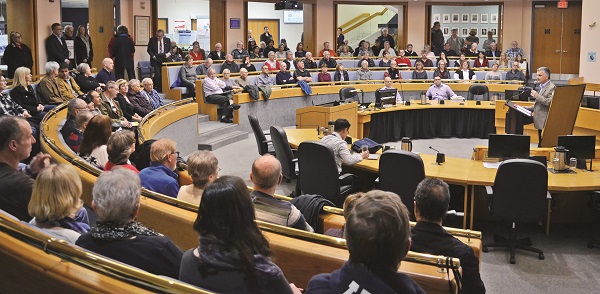General News » News
Technicalities trump common sense in stable neighbourhoods: residents
March 7, 2018 · 0 Comments

By Brock Weir
Lesley Walsh has had enough of local planners burying their faces in technical drawings.
It’s time to come out and pound the pavement to get a good idea of the impact infill developments are having on Aurora’s stable neighbourhoods, she contends.
Ms. Walsh was one of nearly 200 local residents who overflowed Council Chambers Wednesday night at a public forum on the future of Aurora’s so-called “stable neighbourhoods.”
Wednesday’s public open house was convened as part of an ongoing neighbourhood study to determine whether Aurora’s zoning bylaw is effective in maintaining the character of the community’s existing residential neighbourhoods.
The answer to that question from the vast majority of those in attendance was a vast “no.”
“Back in October, Council directed us to undertake the Stable Neighbourhood study,” explained Marco Ramunno, Aurora’s Director of Planning at the start of the two hour session. “It encompasses our stable neighbourhood designation, which is our Official Plan policy that identifies types of uses and development in those areas with specific policies. We also have our specific zoning bylaw which regulates the type of development on a given parcel of land and it sets standards with respect to heights, lot coverage, etc.”
The staff-led presentation outlined the characteristics of existing stable neighbourhoods and defined “compatibility” of new developments within them as “development that may not necessarily be the same or similar to existing buildings in the vicinity, but it has to enhance the established community and co-exist without causing any undue adverse impact.”
This was all well and good in the expressed opinions of most of the people in attendance last week, but the existing zoning bylaws fly in the face of this definition, particularly in provisions that new developments not exceed a lot coverage of 35 per cent in these communities.
Aurora’s existing Official Plan, ratified in 2011, contradicts zoning bylaw provisions still in effect from 50 years ago, they contend, and it is time for the zoning bylaws to be updated to the standards set in the official plan.
“Seven years have passed that we have been stuck with outdated bylaws and little enforcement,” said resident Peter Smith. “It is time for change before our stable neighbourhoods are destroyed forever. In 2018, the lot sizes have not changed but the size of new builds has, in some cases, increased dramatically and are not compatible with our stable neighbourhoods. Some new builds and renovations in our area are very tastefully done and fit well with our community. Others are highly questionable and don’t respect the local environment.
“We accept that change is inevitable, but respectfully ask that the values and identities of our older communities be respected. Bylaws need to be changed to reflect and preserve the character of these older neighbourhoods. In Aurora, subdivisions were built at various times to reflect distinctive and individual characteristics, sometimes on a street by street basis. These facts must be incorporated into new bylaws. At present, we are expected to accept the 1968 bylaws which clearly do not apply to our stable neighbourhoods.”
This was a view shared by Steve D’Angeli who said he lives in a stable neighbourhood characterised by larger houses. People in attendance, he contended, were not against development; rather, they were frustrated with a “discrepancy” between the Official Plan and the reality of the buildings going in.
“I don’t think anyone is looking to restrict a developer’s right to make a buck, to increase property values,” he said. “Nobody here wants property values to go down; I think what people want is compatible development. We have a stable neighbourhood policy and I don’t think anyone here can look at these big developments and say the neighbourhood is stable.
“We have people coming in, they don’t have skin in the game, and they are changing the culture and the makeup of stable neighbourhoods for financial gain and solely for financial gain. Nobody is looking to say they can’t have that financial gain, but there has to be a midpoint and balance in a neighbourhood where people can still go out and have a garden that has sunlight.
“I myself don’t have any skin in the game, I see both sides, but I think the key issue to me here is your Official Plan and your zoning are not linked. Your Official Plan was updated and your zoning bylaw was not.”
With residents seeking answers, Mr. Ramunno told the crowd if Council provides direction to amend the existing zoning bylaws there will be a need for additional public consultation and notices that it is in the works before they can be brought to fruition.
“This is an Open House and it is still going to take some time,” said Mr. Ramunno in front of the gallery, which also included the majority of Council members. “My commitment is a report back to Council as soon as we can.”
In the meantime, many residents issued an invitation for Council members, planners, and the powers-that-be to come out and assess the situation for themselves.
“In some of the answers we have heard, it just seems people are hanging their answers on a technicality and not looking at something and having any kind of common sense,” said Ms. Walsh. “I would like to have people come to the neighbourhood, and not just be buried in their drawings and have some common sense in line with your technicalities. [You keep saying], ‘That’s okay, that’s okay,’ but how can it be?”











